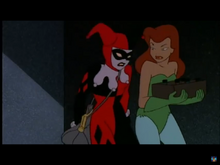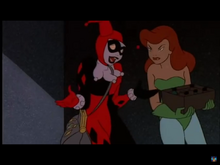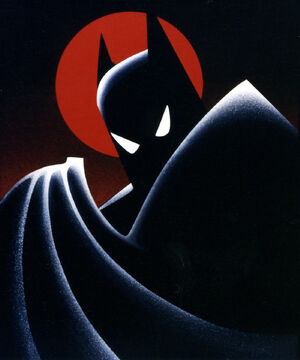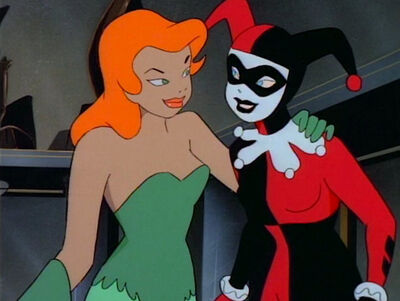Batman the Animated Series Cartoons 90 S
Batman the Animated Series Cartoons 90 S


| Batman: The Animated Series | |
 | |
| Genre | Action/Adventure, Superhero, Mystery, Suspense, Drama, Science Fiction |
|---|---|
| Format | Animated Series |
| Created by | Bruce Timm Eric Radomski |
| Written by | Paul Dini Michael Reaves Randy Rogel Steve Perry Brynne Stephens Sean Catherine Derek Alan Burnett Laren Brilliant |
| Starring | Kevin Conroy Efrem Zimbalist, Jr. Bob Hastings Robert Costanzo Loren Lester Mark Hamill Arleen Sorkin |
| Country of Origin | United States |
| Language(s) | English |
| No. of Seasons | 4 |
| No. of Episodes | 109 (List of Episodes) |
| Production | |
| Executive Producer(due south) | Jean MacCurdy Tom Ruegger |
| Running Time | 22 minutes (approx.) |
| Broadcast | |
| Original Channel | Fox (Flim-flam Kids) The WB (Kids' WB) |
| First Shown | 1992 1997 |
| Original Run | Fox: September 5, 1992 – September fifteen, 1995 The WB: September xiii, 1997 – January xvi, 1999 |
| Status | Ended |
| Wiki | |
 | |

Batman: The Animated Series was an American animated television series based on the DC Comics superhero, Batman. The series was produced past Warner Bros. Animation and originally aired on the Fox Network from September five, 1992 to September xv, 1995. The series was the kickoff in the continuity of the shared DC Animated Universe, and spawned the film Batman: Mask of the Phantasm.
The visual style of the series, dubbed "Nighttime Deco," was based on the artwork of producer and artist Bruce Timm, The series was widely praised for its thematic complexity, dark tone, artistic quality and faithfulness to the character'southward crime-fighting origins. The series also won four Emmy Awards, including Outstanding Blithe Plan.

Plot
The series features the adventures of the Dark Knight of Gotham City equally he battles the evil that inhabits the city with the occasional assist of Robin and Batgirl in stories that are faithful to the comics in both spirit and tone.
Characters
New villains such as Cherry Hook, Baby-Doll, Kyodai Ken, Tygrus, and the Sewer Male monarch were invented for the series, but to little acclaim. On the other hand, the Joker'due south accomplice Harley Quinn, Gotham Urban center police detective Renee Montoya and the vigilante Lock-up achieved such popularity that they became characters in the comics. Older villains that were lesser known from the comics, such as Count Vertigo, the Mirror Man and the Clock King, were modified for the series in both appearance and personality. The series was also the first to suggest that Harvey Paring had a pre-existing dual personality before becoming Two-Confront. This idea came from Alan Burnett, 1 of the serial' producers and head writers.
Aside from creating characters that crossed over into the main line of DC Comics, several of the serial' reinterpretations were carried over besides. Mr. Freeze was revised in the comics to emulate the series' tragic story, the success of which actually compelled DC to bring the character back after "killing" him off some years earlier, Clayface was revised to be much more similar in advent to his animated counterpart, and Ii-Face's double-sided, black-and-white arrange has become a common advent for the graphic symbol.
Ane of the about noteworthy changes fabricated in Batman: The Animated Series was the treatment of Batman's alter-ego Bruce Wayne. In nearly all other media, including the comics, boob tube shows and films, Bruce deliberately plays up his image as a cocky-absorbed and non-besides-bright billionaire playboy. In the animated series, his graphic symbol is instead treated more seriously; he is believing and intelligent, and actively involved in the direction of Wayne Enterprises, without jeopardizing his cloak-and-dagger identity. For example: in the episode "Eternal Youth", Bruce is shown angrily ordering ane of his directors to abolish a clandestine bargain with a timber company in the Amazon rainforest. In add-on, during the episode "Night of the Ninja", he revealed to reporter Summertime Gleeson that he has some martial arts grooming, equally the reporter previously researched that he once lived in Japan, though he later throws a fight with the ninja Kyodai Ken in front of Gleeson to disguise his prowess. The psychological issues stemming from his parents' deaths are ordinarily shown in the form of self-hatred when Bruce is alone. Voice role player Kevin Conroy is notable for existence the first person in animation to use two distinct voices to portray Bruce Wayne and Batman, which was his own idea.
History
The series took influence from Tim Burton'south live-action films Batman and Batman Returns, and the acclaimed Superman theatrical cartoons produced by Fleischer Studios in the early 1940s. In designing the series, Bruce Timm and Eric Radomski emulated Burton's films' "otherworldly timelessness", incorporating catamenia features such equally black-and-white title cards, police blimps (though no such thing existed, Timm has stated that he found it to fit the show's way) and a "vintage" color scheme with film noir flourishes. In addition, Radomski issued a standing order to the animation department that all backgrounds be painted using low-cal colors on blackness newspaper (every bit opposed to the industry standard of nighttime colors on white newspaper). The distinctive visual combination of "noir" imagery and Art Deco blueprint was dubbed "Dark Deco" by the producers.
The series initially took a variation of music written by Danny Elfman for the Burton films as its theme, later episodes of the serial used a new theme with a similar mode past Shirley Walker (Walker was occasionally Elfman's conductor for films on which they collaborated). The score of the serial was influenced by Elfman and Walker's work on the Burton films, likewise as music of 1940s movie noir.
The serial was more developed-oriented than previous superhero cartoons. It was the get-go such cartoon in years to draw outright physical violence confronting antagonists (though only i grapheme was depicted as having been shot — Commissioner Gordon, in the episode "I Am the Night", is shown lying unconscious due to a gunshot wound he received offscreen) and one of the start blithe shows in years to depict realistic firearms. Outset-time producers Timm and Radomski reportedly encountered resistance from studio executives, merely the success of Burton'due south offset film allowed the embryonic series to survive long enough to produce a pilot episode, "On Leather Wings", which, according to Timm, "got a lot of people off our backs".
The series was also notable for its supporting cast — a number of well-known actors provided voices for various classic villains, most notably Mark Hamill (previously famous for his role as Luke Skywalker in the original Star Wars trilogy), who later found success in voice acting thanks to his "cheerfully deranged" portrayal of the Joker. The recording sessions (nether the supervision of voice director Andrea Romano) were recorded with the actors together in one studio (as opposed to industry standard of vocalism actors recording dialogue separately). This method would later be employed for all subsequent series in the DC animated universe.
One of the series' all-time-known innovations was the Joker's assistant, Harley Quinn, who became so popular that DC Comics later added her to mainstream Batman comic book continuity. The Penguin underwent change for the series, his appearance was remodeled after the version seen in Batman Returns (though still incorporating classic elements of the graphic symbol), which was in product simultaneously with the series' first season. New life was also given to lesser-known characters for the series such as the Clock King. In addition, dramatic changes were made to villains such as Clayface and Mr. Freeze — the latter character, for example, was changed from a gimmicky mad scientist to a tragic effigy whose "frigid exterior hid a doomed love and vindictive fury".
Episodes
Batman: The Blithe Series has a total of 109 episodes spread over 4 seasons that were produced from September 1992 to January 1999.
Broadcast History
Batman: The Animated Series premiered on the Fox Network'south children'southward block Fox Kids on September 5, 1992 and aired in that block during weekday afternoons at 4:30pm. In December, just three months after its debut, Fox as well began airing episodes of the series on prime-time Sunday evenings, marking 1 of the few times a show created for Saturday Morn Television receiver was scheduled for prime-fourth dimension broadcast. However, the TV ratings vicious short (as the evidence aired opposite the perennial favorite sixty Minutes), and the series was removed from this time slot in March 1993.
Afterward the serial produced its 65th episode (the minimum number necessary for a TV series to be successfully syndicated), Fox Network executives ordered a second season of twenty more episodes that was afterward reduced to airing weekly on Saturday mornings. The second flavour featured Robin more than prominently and, as a result, was retitled The Adventures of Batman & Robin in the title credits; this run of episodes had two new opening sequences and catastrophe credits. In full, Batman: The Animated Series reached 85 episodes before finishing its original run of episodes on September xv, 1995.
In 1997, following the stop of Fox Kids' five-year exclusive broadcast contract, the series began airing on The WB Network'due south children's block Kids' WB, alongside Superman: The Animated Series , soon making a block-blazon show combining the two shows called The New Batman Superman Adventures. The series was renamed The New Batman Adventures and aired 2 boosted seasons from September 13, 1997 to Jan 16, 1999.
Cartoon Network began airing re-runs of the series on March 2, 1998. From 1998 to 1999, the show was aired afterward Cartoon Network'south action cake Toonami, and and so in 2000 it was aired on Toonami itself.
The show subsequently began re-airing on September 30, 2007 on Toon Disney's Jetix lineup, once again aslope Superman: The Blithe Series (despite Warner Bros. being ane of Disney's biggest competitors).
The Hub started broadcasting the series on September six, 2011. The network aired a 10-episode marathon of the series on July 20, 2012 to coincide with the theatrical release of The Dark Knight Rises and even created an animated version of one of the film's trailers, featuring Kevin Conroy and Adrienne Barbeau re-dubbing Batman and Catwoman'due south dialogue from the trailer.
In Italy, the series re-ran on Mediaset.
Batman the Animated Series Cartoons 90 S
Source: https://90scartoons.fandom.com/wiki/Batman:_The_Animated_Series



Comments
Post a Comment